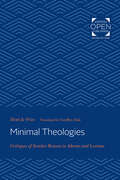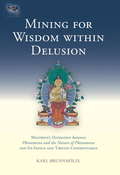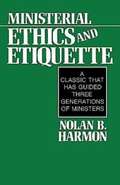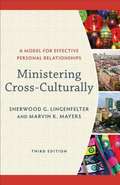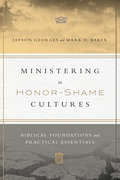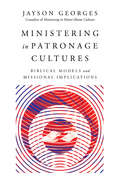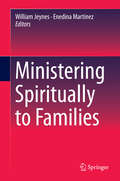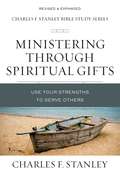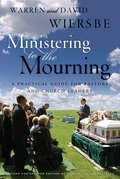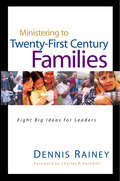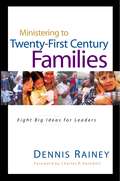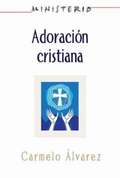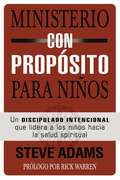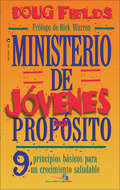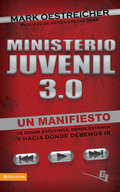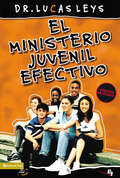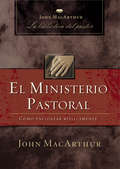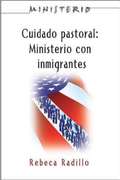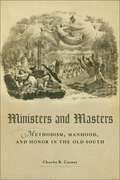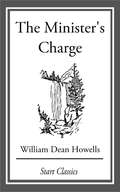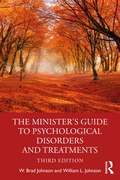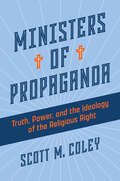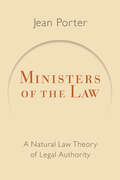- Table View
- List View
Minimal Theologies: Critiques of Secular Reason in Adorno and Levinas
by Hent de VriesOriginally published in in 2004. What, at this historical moment "after Auschwitz," still remains of the questions traditionally asked by theology? What now is theology's minimal degree? This magisterial study, the first extended comparison of the writings of Theodor W. Adorno and Emmanuel Levinas, explores remnants and echoes of religious forms in these thinkers' critiques of secular reason, finding in the work of both a "theology in pianissimo" constituted by the trace of a transcendent other. The author analyzes, systematizes, and formalizes this idea of an other of reason. In addition, he frames these thinkers' innovative projects within the arguments of such intellectual heirs as Jürgen Habermas and Jacques Derrida, defending their work against later accusations of "performative contradiction" (by Habermas) or "empiricism" (by Derrida) and in the process casting important new light on those later writers as well. Attentive to rhetorical and rational features of Adorno's and Levinas's texts, his investigations of the concepts of history, subjectivity, and language in their writings provide a radical interpretation of their paradoxical modes of thought and reveal remarkable and hitherto unsuspected parallels between their philosophical methods, parallels that amount to a plausible way of overcoming certain impasses in contemporary philosophical thinking. In Adorno, this takes the form of a dialectical critique of dialectics; in Levinas, that of a phenomenological critique of phenomenology, each of which sheds new light on ancient and modern questions of metaphysics, ethics, and aesthetics. For the English-language publication, the author has extensively revised and updated the prize-winning German version.
Mining for Wisdom within Delusion: Maitreya's Distinction between Phenomena and the Nature of Phenomena and Its Ind ian and Tibetan Commentaries
by Karl BrunnholzlMaitreya's Distinction between Phenomena and the Nature of Phenomena distinguishes the illusory phenomenal world of sa?s?ra produced by the confused dualistic mind from the ultimate reality that is mind's true nature. The transition from the one to the other is the process of "mining for wisdom within delusion." Maitreya's text calls this "the fundamental change," which refers to the vanishing of delusive appearances through practicing the path, thus revealing the underlying changeless nature of these appearances. In this context, the main part of the text consists of the most detailed explanation of nonconceptual wisdom--the primary driving force of the path as well as its ultimate result--in Buddhist literature. The introduction of the book discusses these two topics (fundamental change and nonconceptual wisdom) at length and shows how they are treated in a number of other Buddhist scriptures. The three translated commentaries, by Vasubandhu, the Third Karmapa, Rangjung Dorje, and Gö Lots?wa, as well as excerpts from all other available commentaries on Maitreya's text, put it in the larger context of the Indian Yog?c?ra School and further clarify its main themes. They also show how this text is not a mere scholarly document, but an essential foundation for practicing both the s?tray?na and the vajray?na and thus making what it describes a living experience. The book also discusses the remaining four of the five works of Maitreya, their transmission from India to Tibet, and various views about them in the Tibetan tradition.
Ministerial Ethics and Etiquette: A Classic That Has Guided Three Generations Of Ministers
by Nolan HarmonA classic guide to ethics since 1928. Nolan Harmon studied the ethical codes of conduct of five major denominations and secured the opinions of eighty-six leading pastors. Harmon uses this wisdom to show ministers how to conduct themselves ethically in virtually every phase of ministry, including special occasion rituals.
Ministering Cross-Culturally: A Model for Effective Personal Relationships
by Sherwood G. Lingenfelter Marvin K. MayersWith more than 125,000 copies in print, this model for effective personal relationships in a multicultural and multiethnic world has proven successful for many. <p><p> On the occasion of its thirtieth anniversary, this contemporary classic has been thoroughly updated to reflect Sherwood Lingenfelter's mature thinking on the topic and to communicate with modern readers, helping them minister more effectively to people of different cultural and social backgrounds. It is accessible, practical, and applicable to many ministry situations. An accompanying interactive questionnaire, designed to help students reflect on their own cultural values, is available online through Baker Academic's Textbook eSources.
Ministering in Honor-Shame Cultures: Biblical Foundations and Practical Essentials
by Mark D. Baker Jayson GeorgesMinistering in Honor-Shame Cultures
Ministering in Patronage Cultures: Biblical Models and Missional Implications
by Jayson GeorgesPatronage governs many relationships in Majority World cultures. But regrettably, Western theologians and missionaries rarely notice this prominent cultural reality.Ministering in Honor-Shame Cultures
Ministering Spiritually to Families
by William Jeynes Enedina MartinezThis book combines the research on spiritual ministering with the practice of counseling families. It examines such topics as how to prepare for marriage, how to keep a marriage divorce proof, and how parents influence children, and vice versa. In its quest to discover what makes families thrive, the book addresses and compares best parenting practices and describes interventions that help the development of family ties over a large span of the life-course. It offers guidance to families through several stages of family life: Pre-marital, marital, and raising children and adolescents. It makes clear that what constitutes an effective parent changes over the life course.
Ministering Through Spiritual Gifts: Use Your Strengths to Serve Others (Charles F. Stanley Bible Study Series)
by Charles F. StanleyWhat are your gifts? How are you using your abilities to grow God&’s kingdom? In Ministering Through Spiritual Gifts, you will find how to pinpoint your God-given strengths by exploring the seven gifts listed in Romans 12. You will be challenged to consciously develop these gifts—not for your own personal gain, but to minister to others. Challenging, thought-provoking, and deeply rooted in Scripture, this Bible study calls you to deeper service to the Lord as you embrace the ministry gifts He has given you.The Charles Stanley Bible Studies are a unique approach to Bible study, incorporating biblical truth, personal insights, emotional responses, and a call to action. Each study draws on Dr. Stanley's many years of teaching on the guiding principles found in God's Word, showing how we can apply them in practical ways to every situation we face. This edition of the series has been completely revised and updated and includes two brand-new lessons from Dr. Stanley.
Ministering to the Mourning: A Practical Guide for Pastors, Church Leaders, and Other Caregivers
by Warren W. Wiersbe David WiersbeFormerly titled Comforting the Bereaved, this practical, insightful guide gives direction to pastors and lay-leaders of all levels of experience. Included are recommended Scriptures to read; an explanation of the stages of grief; approaches to conducting funerals in special circumstances such as suicide, victims of crime, multiple family deaths, or when the deceased is unknown to the pastor; signs of healthy and unhealthy grief, and how to help survivors cope. This new edition contains a chapter on ministering to victims of terrorism. It is also recommended for chaplains and hospice caregivers.
Ministering to the Mourning: A Practical Guide for Pastors, Church Leaders, and Other Caregivers
by Warren W. Wiersbe David WiersbeFormerly titled Comforting the Bereaved, this practical, insightful guide gives direction to pastors and lay-leaders of all levels of experience. Included are recommended Scriptures to read; an explanation of the stages of grief; approaches to conducting funerals in special circumstances such as suicide, victims of crime, multiple family deaths, or when the deceased is unknown to the pastor; signs of healthy and unhealthy grief, and how to help survivors cope. This new edition contains a chapter on ministering to victims of terrorism. It is also recommended for chaplains and hospice caregivers.
Ministering to the Oppressed (Volume 3 of the Satan, Demons, and Demon Possession Series)
by Kenneth E. HaginIn Volume 3 of the Satan, Demons, and Demon Possession Series, Kenneth E. Hagin states at the beginning of chapter 1, "In this third volume in a series on the devil and demons, I want to teach particularly about demon oppression and the operation of the spiritual gift of discerning of spirits (1 Cor. 12:10)."
Ministering to Twenty-First Century Families
by Dennis RaineyThere is nothing traditional about the typical family of the twenty-first century, and so it follows that ministering to today's families presents an assortment of new challenges. Rainey believes that the resources needed by the church to confront and combat family problems do exist, and Ministering to Twenty-First Century Families is a user-friendly guide to combating the destruction of the family unit. Offering practical solutions and encouraging action, Rainey calls for a "roll-up-your-sleeves" approach to healing weary families.
Ministering to Twenty-First Century Families
by Charles Swindoll Dennis RaineyThere is nothing traditional about the typical family of the twenty-first century, and so it follows that ministering to today's families presents an assortment of new challenges. Rainey believes that the resources needed by the church to confront and combat family problems do exist, and Ministering to Twenty-First Century Families is a user-friendly guide to combating the destruction of the family unit. Offering practical solutions and encouraging action, Rainey calls for a "roll-up-your-sleeves" approach to healing weary families.
Ministerio | Adoración cristiana: Teología y práctica desde la óptica protestante
by Association for Hispanic Theological EducationEste libro examina el tema de la adoración cristiana desde el punto de vista del protestantismo y la diversidad dentro de este. Es en esta diversidad que se han configurado modelos distintos en la organización eclesiástica y ha resultado en una adoración marcadamente creativa y flexible. El autor nos guiará por el desarrollo histórico de esta adoración y expondrá algunos de los modelos básicos. Written in Spanish, this book examines the topic of the Christian worship and its diversity from the Protestant perspective. This diversity has contributed to the configuration of different worship models in the ecclesiastical organization that results in a flexible and creative worship. The author will guide us for the historic development of Christian worship and discuss some of the basic models.
Ministerio con propósito para niños: Un discipulado intencional que dirige a los niños hacia la salud espiritual
by Steven J. AdamsMuchos ministerios de niños son un frenesí de actividad, dirigidos por dedicados voluntarios y personal que emplean largas horas y duro trabajo para el bien de los niños y los padres a quienes sirven. Sin embargo, a pesar de las buenas intenciones, muchos ministerios de niños actualmente no son eficaces. Carecen de propósito e intencionalidad. Un veterano por veinticinco años del ministerio de niños en la iglesia local, el pastor Steve Adams, ha ministrado a familias en múltiples iglesias, desde congregaciones diminutas hasta su actual posición en la iglesia Saddleback. En este libro, Steve aplica las revolucionarias perspectivas de Una iglesia con propósito al ministerio de niños y guía a los lectores en un viaje de descubrimiento y alteración, mostrándoles cómo desarrollar un proceso ministerial intencional que dirija a los niños hacia la salud espiritual a la vez que edifica un ambiente ministerial saludable para quienes trabajan con niños. Aprenderás cómo hacer y responder cinco preguntas sencillas pero poderosas: • ¿Por qué estamos en este viaje? • ¿Qué necesitamos para cumplir nuestra misión? • ¿A quiénes intentamos alcanzar? • ¿Cómo movilizaremos a nuestros niños hacia la salud espiritual? • ¿Dónde estamos ahora y hacia dónde vamos? No hay una clave única para un ministerio de niños exitoso ni tampoco hay un solo camino que funcione para todo el mundo. Pero hay un proceso demostrado que se puede seguir, y Steve muestra cómo ministerios infantiles en todo el mundo están alcanzando el potencial que Dios les ha dado al descubrir su propósito bíblico, evitando las trampas de la frustración y el agotamiento.
Ministerio de jóvenes con propósito: 9 Principios básicos para un crecimiento saludable
by Doug FieldsMINISTERIO DE JÓVENES CON PROPÓSITO Si quiere alcanzar a los jóvenes y ver que Dios cambia sus vidas, esta detallada guía le mostrará cómo. Avanzando en torno a los propósitos fundamentales de evangelización, discipulado, compañerismo, ministerio y adoración, Ministerio de Jóvenes con Propósito usa las experiencias de la iglesia Saddleback para ilustrar lo que puede hacer un ministerio de jóvenes saludable. He aquí nueve principios básicos que le ayudarán a: • Conectarse con el poder de Dios en un entusiasta y comprometido liderazgo • Definir el propósito de su ministerio y comunicarlo con eficiencia • Identificar su audiencia potencial • Crear programas que lleguen a su audiencia y cumplan los propósitos de Dios • Implementar métodos que conduzcan a los estudiantes hacia la madurez • Enriquecer su ministerio con valores bien definidos • Trabajar en equipo con los padres para que participe toda la familia • Buscar voluntarios y convertirlos en líderes • Perseverar a través de los tiempos difíciles y prosperar en un ambiente de cambio constante Con su combinación de la teoría con la práctica, Ministerio de Jóvenes con Propósito se ajusta a cualquier iglesia, sin importar tamaño, denominación, facilidades, recursos ni líderes. Este libro le ayudará a desarrollar un ministerio que equipe a los estudiantes en vez de simplemente coordinar actividades. Doug Fields dice: >.
Ministerio juvenil 3.0: Un manifiesto de donde estuvimos, donde estamos y hacia donde debemos ir
by Mark OestreicherDurante las últimas décadas han ocurrido cambios significativos en la cultura juvenil, y cada nuevo cambio ha traído consigo diferentes valores y prioridades en la vida de los adolescentes. En la medida que los ministerios juveniles se adaptan y responden apropiadamente a estas épocas, parece que hemos perdido el bote de la tercera, lo que nos ha puesto hoy, en un lugar en el cual el ministerio juvenil no se está ocupando de las realidades y necesidades de la cultura juvenil. Después de haber estado en este ministerio durante casi tres décadas, Mark Oestreicher ha vivido muchos de estos cambios. Pero en los años recientes, él se ha venido preguntando qué hay que cambiar en el ministerio juvenil. En Ministerio Juvenil 3.0 entenderás, junto a Mark y a otros líderes de jóvenes, por qué necesitamos un cambio en el ministerio juvenil. Conocerás una breve historia de dicho ministerio durante los últimos 50 años, así como los cambios necesarios para crear la próxima fase de este… el futuro que necesitamos erigir para ministrar en forma eficaz a los adolecentes. Ante la encrucijada en que se encuentra el ministerio juvenil, este libro nos proporciona una visión del rumbo que debería tomar a partir de aquí.
El ministerio juvenil efectivo
by Lucas LeysEl propósito de este libro es proponer estrategias, ideas y principios para desarrollar un liderazgo juvenil inteligente compartiendo las claves del ministerio juvenil efectivo. En "El ministerio Juvenil efectivo" conversarás con uno de los más respetados ministros de la juventud acerca de: "Cómo entender las cuestiones del desarrollo" "Cómo enfocarse a la gran meta y los cuatro propósitos del ministerio juvenil" "Cómo elaborar programas acertados y actividades que produzcan explosión" "Cómo construir relaciones significativas y seguir mejorando tu discipulado" "Cómo llevar a cabo un liderazgo sobresaliente" "Cómo hacer contact con la cultura que queremos invadir"
El ministerio pastoral: Cómo pastorear bíblicamente
by John MacarthurSi está tratando de condensar el ministerio pastoral enun volumen, ¡aquí lo tiene!Alentador, perspicaz y desafiante, El ministerio pastoral está diseñadopara una nueva generación de pastores que tratan de dirigir con la pasión delos apóstoles. Escrito por MacArthur y sus colegas en The Master's Seminary, estaguía bosqueja las prioridades bíblicas esenciales para un ministerio eficaz.Otros colaboradores incluyen a: Richard L. Mayhue, James F.Stitzinger, Alex D. Montoya, James M. George, Irvin A. Busenitz, James E.Rosscup, Donard G. McDougall, Robert L. Thomas, David C. Deuel, George J. Zemeky S. Lance Quinn.
Ministerio series (AETH) - Cuidado Pastoral: Ministerio con Inmigrantes
by Assoc for Hispanic Theological EducationLa experiencia migratoria suscita un sinnúmero de situaciones complejas que presentan un reto súbito e inesperado al liderazgo pastoral. En su tarea pastoral el líder se enfrenta diariamente con gran número de personas que reflejan y le recuerdan su propia condición, así como sus conflictos y dificultades, como inmigrante en muchos casos. Tal experiencia pude resultar agotadora y emocional y espiritualmente debilitante, debido a la identificación o sobreidentificación con las personas a quienes sirve. Este libro explora estas ideas y sus dinámicas. The immigration experience stirs up an endless number of complex situations that present a sudden and unexpected challenge to pastoral leadership. In their Hispanic ministerial task, every day, church leaders are faced people who share their struggles and conflicts - particularly immigrants. Effectively carrying out this ministry can be exhausting and emotional and spiritually debilitating, due to the unique difficulties this ministry faces. This book explores ideas and the dynamics of this ministry.
Ministers and Masters: Methodism, Manhood, and Honor in the Old South
by Charity R. CarneyIn Ministers and Masters Charity R. Carney presents a thorough account of the way in which Methodist preachers constructed their own concept of masculinity within -- and at times in defiance of -- the constraints of southern honor culture of the early nineteenth century. By focusing on this unique subgroup of southern men, the book explores often-debated concepts like southern honor and patriarchy in a new way.Carney analyzes Methodist preachers both involved with and separate from mainstream southern society, and notes whether they served as itinerants -- venturing into rural towns -- or remained in city churches to witness to an urban population. Either way, they looked, spoke, and acted like outsiders, refusing to drink, swear, dance, duel, or even dress like other white southern men. Creating a separate space in which to minister to southern men, women, and children, oftentimes converting a dancehall floor into a pulpit, they raised the ire of non- Methodists around them. Carney shows how understanding these distinct and often defiant stances provides an invaluable window into antebellum society and also the variety of masculinity standards within that culture. In Ministers and Masters, Carney uses ministers' stories to elucidate notions of secular sinfulness and heroic Methodist leadership, explores contradictory ideas of spiritual equality and racial hierarchy, and builds a complex narrative that shows how numerous ministers both rejected and adopted concepts of southern mastery. Torn between convention and conviction, Methodist preachers created one of the many "Souths" that existed in the nineteenth century and added another dimension to the well-documented culture of antebellum society.
The Minister's Charge: The Apprenticeship of Lemuel Barker
by William Dean HowellsWilliam Dean Howells (1837-1920) was an American realist author and literary critic. He wrote his first novel, Their Wedding Journey, in 1871, but his literary reputation really took off with the realist novel A Modern Instance, published in 1882, which describes the decay of a marriage. His 1885 novel The Rise of Silas Lapham is perhaps his best known, describing the rise and fall of an American entrepreneur in the paint business. His social views were also strongly reflected in the novels Annie Kilburn (1888) and A Hazard of New Fortunes (1890). While known primarily as a novelist, his short story "Editha" (1905) - included in the collection Between the Dark and the Daylight (1907) - appears in many anthologies of American literature. Howells also wrote plays, criticism, and essays about contemporary literary figures such as Ibsen, Zola, Verga, and, especially, Tolstoy, which helped establish their reputations in the United States. He also wrote critically in support of many American writers. It is perhaps in this role that he had his greatest influence.
The Minister's Guide to Psychological Disorders and Treatments
by W. Brad Johnson William L. JohnsonIn its third edition, The Minister’s Guide to Psychological Disorders and Treatments is the definitive guide to everything a minister might need to know about the most common psychological disorders and current evidence-based mental health treatments. Written in straightforward and accessible language, this is the minister’s one-stop guide to understanding common mental health problems, helping parishioners who struggle with them, and thinking strategically about whether to refer —and if so, to whom. This updated edition is fully aligned with the latest edition of the Diagnostic and Statistical Manual of Mental Disorders (DSM-5-TR) and the most current evidence-based psychological treatments. This third edition infuses significant attention to culture and diversity, with diverse case examples and fresh content on cultural humility, diagnostic interviewing, assessment, sociocultural contributors to mental health disorders, such as religious community, race, and gender. The third edition also includes coverage of more treatment strategies such as mindfulness, medical cannabis, and light therapy for seasonal depression, as well as revised sections and updated references on major psychological disorders and childhood and relationship problems, including gender dysphoria, binge eating disorder, and intellectual disabilities. Written with deep empathy for the demands of contemporary pastoring, this guide is destined to become an indispensable reference work for busy clergy in all ministry roles and settings.
Ministers of Propaganda: Truth, Power, and the Ideology of the Religious Right
by Scott M. ColeyScott Coley exposes the inner workings of the religious right&’s propaganda—and how Christians can resist it. Good evangelical Christians are Republican. It seems like it&’s always been this way. That means the propaganda is working. Scott Coley trains a critical eye on the fusion of evangelicalism and right-wing politics in Ministers of Propaganda. This timely volume unravels rhetoric and biblical prooftexting that support Christo-authoritarianism: an ideology that presses Christian theology into the service of authoritarian politics. Coley&’s historically informed argument unsettles evangelical orthodoxy on issues like creation science or female leadership—convictions not as unchanging as powerful religious leaders would have us believe. Coley explains that we buy into propaganda because of motivated reasoning, and when we are motivated by perceived self-interest, the Christian message is easily corrupted. But if we recover Jesus&’s commandment to love our neighbors as ourselves, right-wing propaganda will lose its power. Any reader troubled by American evangelicals&’ embrace of racism, misogyny, and other unchristian views will find answers and hope in these pages.
Ministers of the Law: A Natural Law Theory of Legal Authority (Emory University Studies in Law and Religion)
by Jean PorterIn Ministers of the Law Jean Porter articulates a theory of legal authority derived from the natural law tradition. As she points out, the legal authority of most traditions rests on their own internal structures, independent of extralegal considerations -- legal houses built on sand, as it were. Natural law tradition, on the other hand, offers a basis for legal authority that goes beyond mere arbitrary commands or social conventions, offering some extralegal authority without compromising the independence and integrity of the law. Yet Porter does more in this volume than simply discuss historical and theoretical realms of natural law. She carries the theory into application to contemporary legal issues, bringing objective normative structures to contemporary Western societies suspicious of such concepts.
